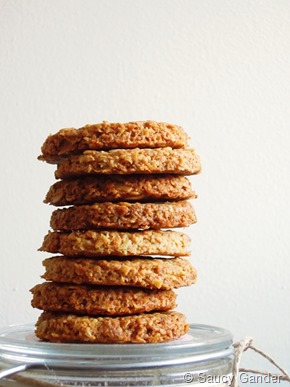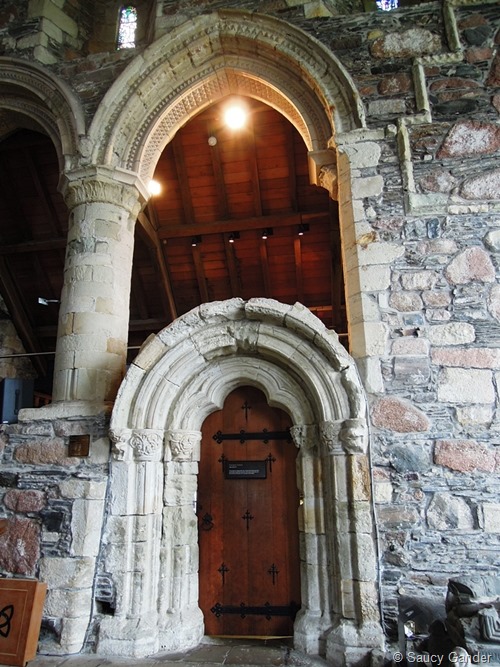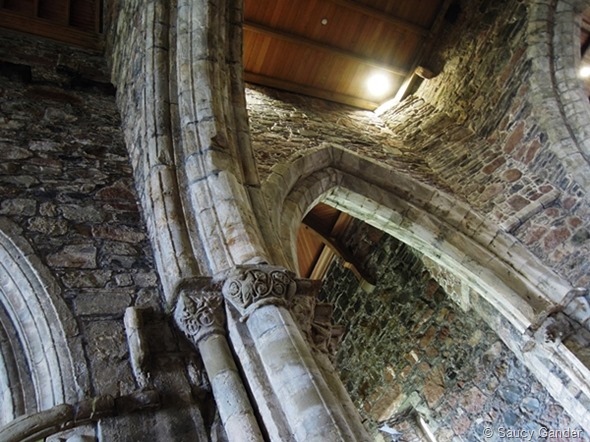
Sometimes, a phrase, an image, or an object triggers your memory and it’s as though you are transported back to another place. Last night, reading Laura’s blog, Laura’s Mess, I remembered standing under Western Australia’s big, open sky, with its sense of so much space, feeing the warm wind and warmer sun, and ouch-hot white sand under my feet.
Earlier that evening, we were planning a dinner party for 12 (!). Cheese and oatcakes got on the menu. And I remembered the oatcakes we had in Scotland. And that story on a packet of oatcakes, solemnly explaining that oatcakes began from the Scottish people’s frugal habits, when they would save their morning porridge by drying it into a cake for supper.
Dried leftover porridge. Yum.
So it was that I found myself making oatcakes that evening.
I used a recipe from Hugh Fearnley-Whittingstall who introduced it thus: “This recipe is Bill Cowie’s, island manager of Rona in the Inner Hebrides. He made a batch when we were filming and fishing with him in July. We devoured every last one, with cheese and homemade chutney.”


I almost followed the recipe, the only changes I made were adding a bare half teaspoon of crushed lavender, and an overflowing teaspoon of honey, into the oatcake mix. I’ve been reading about lavender pepper spice mixes, and oats just love honey, and the whole thing just came together.
The oatcakes had a healthy back of the throat kick from a mixture of black and white pepper – I’d like to use the sweeter pink pepper next time – a bare hint of open grassland from the lavender, and the barest mellowness from the honey. Their flavours played off each other and made me want to use the lavender, honey and pepper combination in other things.
The oatcakes were so very crumbly, and just out of the oven they had a golden toasted flavour. All we needed was a strong cheddar and home made chutney.

Reading about the Hebrides also reminded me that I have yet to share photos from the Isle of Iona. Eeeep. A few of the photos are after the recipe.
Honey, lavender and pepper oatcakes
(mostly based on this recipe for Bill’s Rona oatcakes, published by Hugh Fearnley-Whittingstall)
Ingredients
140g medium oatmeal
140g porridge oats
10 twists of black pepper (I used a mixture of white and black pepper, pink pepper would be nice)
½ tsp salt
75ml extra-virgin olive oil
Add-in: a small handful of sunflower or other seeds, or a tiny amount (half to one tsp crushed culinary lavender – just make sure the final cookies don’t taste like potpourri or grandma’s sock drawer) and a heaping tsp of honey.
Method
1. Preheat the oven to 180C/350F/gas mark 4 and dust two baking trays with flour. Mix all the dry ingredients in a bowl. Pour the oil into a well in the centre, then pour in enough boiling water to bind it into a firm, not sticky, dough. Work quickly. Don’t worry if you over-water a bit – you can remedy the situation by adding more oatmeal.
2. Form the dough mixture into a ball and leave it to rest for 2-5 minutes (Fearnley-Whittingstall describes this as the time it takes to open a bottle and pour a glass of wine). Roll out the dough on a floured surface (dust with flour, too, if it’s sticky) to about 5mm thick.
3. Cut out discs with a cookie cutter (I used a small wineglass). Place on the baking trays and bake for 20 minutes, then turn and bake for a further five to 10 minutes. Cool on a rack. Store in an airtight container.
~~~~~
Iona Abbey and surrounds

This was a magical day in the Inner Hebrides. We were finally getting off the mainland and going onto the islands.
Iona has long fascinated Mr Gander, who is the historian around here, and has wanted to visit Iona since reading about the early Christian history associated with this island. Before our trip, while I was on Tripadvisor every day, he found time to read Johnson and Boswell’s accounts of their trip to Scotland and the Hebrides – in 1773. So he told me that Iona was yet to be restored in the 18th century, and Johnson and Boswell may have found the Convent used to keep pigs. He also told me, gleefully, about tourist accommodation in 1773, which consisted of lavish or threadbare castles (if you had a letter of introduction), or any old barn.
Um, thanks.

Luckily for us, the residents of Iona and the Duke of Argyll (who had a castle in Inverary, which was featured in Downton Abbey) had restored the Abbey and got the pigs out of the Convent. There were still signs that the Abbey had been exposed to the Hebridean climate – ferns growing in columns, dripping patches of damp on the walls. But all this added to its rather solemn atmosphere, when seen next to the rows of chairs and bibles used by the island residents today. The Abbey also had such beautiful, mysterious play between light and shadow.




I found myself becoming contemplative, thinking about how the early monks lived, devoted their lives to creating illuminated manuscripts like the Book of Kells, and carried it to Dublin in long boats.
We also saw our first Calmac ferry on the way to Iona. I may have squealed as we drove the car onto the ferry in Oban… and to top it off, a Royal Mail van was on the Iona ferry with us, I really wanted a Royal Mail van of my own.
There’s no Royal Mail van in our carpark, yet. To sign off, here is one more photo showing the moody fantastical sunlight in the Hebrides (plus the clouds and the constant threat of rain).

Tagged: food photography, Hebrides, honey, Hugh Fearnley-Whittingstall, Inner Hebrides, Iona, lavender, Oatcakes, pepper, River Cottage, Rona, Scotland, Scottish, travel photography

 Saucy Gander. Adventuress in the kitchen and beyond. Amateur cook, baker, traveller, occasional dinner party hostess. I read copiously, blog unprofessionally, and eat almost incessantly. I am an un-trendy resident of Sydney inner west, have never eaten a cake pop, and don't have a DSLR.
Saucy Gander. Adventuress in the kitchen and beyond. Amateur cook, baker, traveller, occasional dinner party hostess. I read copiously, blog unprofessionally, and eat almost incessantly. I am an un-trendy resident of Sydney inner west, have never eaten a cake pop, and don't have a DSLR.
Stunning. The whole post from beginning to end. 🙂
Thank you so much!
What an amazing trip! And those oatcakes? Wow. new to me, but really want to make them. Only a genius would add lavendar 😉 Curious: How is the oatmeal different from the porridge? Is porridge cooked oats?
I had to Google this question and guess what the recipe is asking for!
Oatmeal refers to oats that have been ground up so they can be used like flour. For medium oatmeal, I took good quality instant oats and pulsed them in the food processor for a second.
Porridge oats are still uncooked oats, but seemed to be halfway between rolled oats (which are still whole oats) and oatmeal. And I’m pretty sure they are different from steel cut oats. So I took rolled oats and again pulled them in the food processor for a couple of second to break them up a bit.
Amazing how the same thing has such different names, sounds like something for a blog post!
wow–thanks for the research! Did not know any of that. In my mind, porridge is cooked grains. ?? So oatmeal is oat flour?
Yes, oatmeal is a coarse oat flour, and porridge here seems to mean the type of oats that’s used to make porridge, rather than the finished product.
Johnny has also chimed in about this question, pointing to this link (and he’s a true Britisher so he must be right!) http://www.flourbin.com/cgi-bin/pnDbDetail.cgi?data=faqs&record_id=44&mode=user&action=display
The things we learn everyday!! 🙂
Glad I’m not the only one who doesn’t know and appreciate the link. Funny how it’s regional. Thanks for the education 🙂
Hehe I have oatcakes on the brain too! I tried a whole lot of them when I was in Canada and they’re a variation on the Scottish oatcake! 😀 These look fantastic!
Ah Canada, that looked like an amazing trip you had. Scotland and Canada should have an oatcake-off! 🙂
Very impressive. Really compelling stunning photography. A pleasure to scroll through the photos. On another note, for we Americans, what’s the difference between porridge oats and oatmeal? Is it the same as what we would know as steel-cut oats vs. rolled oats? A second thanks. Ken
Hi Ken, I had to jump on Google and then make some guesses about the oats.
I think oatmeal is oats that have been ground and could be used like flour. I have seen oatmeal explained as oats that are done ground, so the pieces are of different sizes (unlike steel cut) and so produce a creamier texture in porridge.
Porridge oats is (I think) different from steel cut oats, as steel cut is also called pinhead oats in England or Scotland. It seems to be oats that have been rolled until they are about to lose their shape, so as a substitute I put some rolled oats through the food processor for a couple of seconds.
Hope that helps?
Isn’t it wonderful how different food can evoke such strong (and often fabulous) memories of locations around the globe! Magical! Your photos of Iona are simply beautiful!
This link may help to clarify the differences: http://www.flourbin.com/cgi-bin/pnDbDetail.cgi?data=faqs&record_id=44&mode=user&action=display . Although, it sounds like you’ve almost got it. Apart from possibly the porridge, which is probably more like your instant oats. I have medium oatmeal, like wholemeal or whole wheat flour, porridge and jumbo, the latter is rolled but only flattened so they keep their shape. Best used for biscuits and porridge that takes longer to cook. Still haven’t used them! Bought them for flapjacks that I was developing several months ago, and couldn’t find them initially.
Wow, thanks! Knew I could turn to you for answers! 🙂 I’m still intrigued that something as simple as oats can have such different names and categories across the pond/ocean. But then there’s also bulgur, cous cous, semolina, and other stuff to do with wheat. So it’s not just oats.
Soooo beautiful! The food and the photos of Iona. Stunning.
Thanks!
Really lovely post. And you can turn something as simple as an oatcake into a work of art in words and pictures!
Thank you so much, though you should have seen the mess when I was cleaning up the honey drips! 🙂
This sounds lovely! I love the combination of lavender and honey. Sounds delicious! And your photos of Iona Abbey are stunning!
Thanks so much! Am loving adding lavender to cooking and baking!
Lovely to see photos of Iona and a great recipe. Have seen the Book of Kells many times, nice to see where it originated.
Thank you. Iona was such a beautiful place, we were lucky to have the chance to visit.
How did I miss this post before? I love it, every part of it, particularly the photographs of that gorgeous honey drizzling down the side of the oatcakes (and Iona of course, gorgeous!). My husband is of Scottish heritage and I’ve always wanted to take a pilgrimage to Scotland with him, packing oatcakes to eat in the Highlands on a biting cold day. Maybe next year. Argh, too many plans, not enough time or money. Anyway, in the meantime, I can eat these oatcakes…. I’m sensing a bake-up this weekend!! xx
Scotland is so beautiful, I’d love to munch on oatcakes while climbing a Munro! We also seem to have too many plans with not enough time or money. But we can plan and have bake-ups and cook-offs in the meantime. Right?